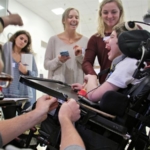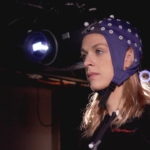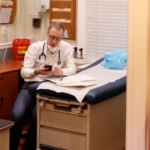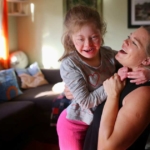UMBC robotics student invents help for those with disabilities like hers
| Kavita Krishnaswamy is a PhD candidate in Computer Science at the University of Maryland, Baltimore County (UMBC) working with Dr. Tim Oates. She is both a Ford Foundation Predoctoral and National Science Foundation Graduate Research Fellow. She has also worked at the National Science Foundation’s Engineering Research Center – Quality of Life Technology Center (QoLT) in Carnegie Mellon and University of Pittsburgh and IBM Business consulting services. Thank you to IEEE RAS ICRA 2015 for allowing us to film at the event this year. YouTube Jun 8, 2015 |
By Jonathan M. Pitts, The Baltimore Sun September 15, 2017
Kavita Krishnaswamy had labored through a decade of coursework in math and computer sciences to achieve a perfect 4.0 grade-point average. The University of Maryland, Baltimore County graduate student had invented robotic devices that are discussed around the world. She’d spent three years narrowing the focus of her doctoral dissertation.
But when the day arrived to defend her dissertation proposal before the panel of senior academics who would allow her to proceed, she never showed up.
She sent her robot.
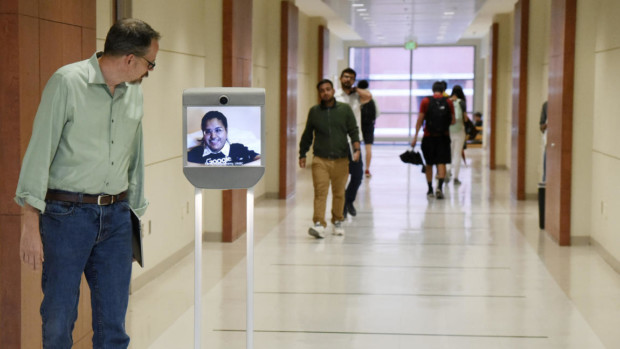
Dr. Tim Oates and Kavita Krishnaswamy, Columbia, move down a hallway in the Information Technology and Engineering building at UMBC. Kim Hairston, Baltimore Sun
Krishnaswamy lives with spinal muscular atrophy, a rare genetic disorder in which a breakdown of nerve cells in the brain and spinal cord prevents the brain from sending the messages that direct muscular movement. She defended her proposal the way she participates in every class and lecture — through the Beam, a rolling, two-way-telecasting robot that she operates from 16 miles away.
Paralyzed from the neck down but for a few muscles in her right hand, the 35-year-old Columbia woman needs round-the-clock care and rarely leaves her home. But she spends her days and nights designing devices that, like the robot she uses to visit UMBC and points beyond, help those living with severe disabilities to attain greater independence.
Already a recipient of Ford and National Science Foundation fellowships, she has now earned more funding for her research from two more awards: the Microsoft Fellowship and the Google Lime Scholarship.
Krishnaswamy designs robotic devices to allow severely disabled people to move their arms and legs simply by moving a computer trackball, speaking or changing their facial expressions. She is pursuing a doctorate in computer science.
“I’m always asking how technology can help a person who has a disability become more independent,” she says. “We need to keep creating more and better technology so that society as a whole can be more independent.”
Krishnaswamy, who is due to earn her doctorate next year, is working with one eye on the clock. Her illness is progressive. It could rob her of her remaining mobility — and her ability to breathe — with little warning.
Changing the world is a lot to ask of anyone, let alone a person who needs a machine to connect with it, and has no idea whether her time on Earth is numbered in decades, years or weeks.
Those who know Krishnaswamy say if anyone can invent a way, she can.

Pushpa Krishnaswamy puts eyeglasses on her daughter, Kavita Krishnaswamy, in their Columbia home. Kim Hairston, Baltimore Sun
| Building to specs |
Krishnaswamy was born in the Indian state of Tamil Nadu, the daughter of Ramesh Krishnaswamy, who holds a Ph.D. in physics, and his wife, Pushpa, who has a B.A. in economics.
SMA affects one in every 10,000 births. In healthy individuals, a gene known as SMN1 produces a protein needed by the motor neurons that control most muscles. People with SMA can’t animate those muscles, leaving them to atrophy and eventually become paralyzed from disuse.
Sixty percent have the severest form of SMA, Type I, which appears during infancy, makes breathing difficult, and usually causes death by age 2. Another 20 percent have Type II, which materializes after a child learns to sit up and prevents further development.
Type II patients never crawl,walk or stand. All settle into a plateau of gradually decreasing strength.
All need extensive caregiving. A few survive into their 50s.
Dr. Thomas Crawford, a pediatric neurologist with Johns Hopkins Medicine who has treated Krishnaswamy since she was 12, says her condition is not unusual for a Type II adult.

Pushpa Krishnaswamy places her daughter’s hand on a trackball. Kim Hairston, Baltimore Sun
“She is profoundly weak,” he says. “She’s not sitting. She manages [her] communication device with the barest little bit of power in her fingers. She has her eyes and her voice — those work. And she has her intelligence, which is substantial.”
In some ways, Krishnaswamy’s life has been a process of harnessing that intelligence and putting it to effective use.
Growing up, she was always a star in math, even as she dealt with skeletal pain and spinal fusion surgeries. She could operate a wheelchair during her high school years but had no idea whether she’d ever have the strength or the opportunity to attend college.
In 1998, as a member of the math, engineering and science achievements club at Wilde Lake High School in Columbia, she became the first student in school history to take part in the statewide robotics competition sponsored by the Institute of Electrical and Electronics Engineers.
Unable to construct a device herself, she designed one digitally. Her younger brothers built it to her specs.
The competition was a race. Her device — a robot encased in a penguin costume — won third place, and a light went on in her mind.
“I was thinking maybe there’s something I can really do with this,” she recalls. “Maybe I could do something more helpful to others. Maybe I could help to design the kind of technologies that could help people like me.”
| Bridging a gap |
Talk with Krishnaswamy about her achievements — whether it’s in person, by Skype, or via the Beam, the nearly $15,000 telepresence device she uses to conduct her academic and professional business — and she’ll eventually sound like an Academy Award winner thanking the many people who have made her success possible.
First come her parents, particularly her mother, who have provided most of the hands-on care throughout her life, from feeding and bathing her to moving her hand to the mouse she uses to operate her computer.
“My children’s lives are very important to me, so there is no job too difficult for me,” Pushpa says. “Nothing equates to a mother’s care.”
The message took root.
“My parents always told me never to give up,” Krishnaswamy says, “and never to let failure near me.”
Then there are the Howard County teachers who expanded her sense of what was possible for her: MESA adviser Marie Boston, who convinced her she could succeed in the IEEE competition, and Fran Dummett, who drove her to the UMBC campus to show her a college she believed would welcome her, and others.
At UMBC, associate vice provost Renetta Tull introduced Krishnaswamy to the Louis Stokes Alliances for Minority Participation, a National Science Foundation program that encourages members of historically underrepresented groups to take part and thrive in STEM studies.
When her hand grew too weak to hold a pencil, math professor Muddappa Gowda showed her an app on which to type mathematical notations. When getting to campus became too hard, computer science professor Charles Nicholas gave her the idea of attending classes virtually, by Skype.
“Dr. Nicholas helped me bridge the physical gap between home and college and gave me the confidence to adapt to new challenges,” she says.
Her strength fading, Krishnaswamy maintained a 4.0 grade-point average as a math-computer science double major. And she sought out a niche of her own.
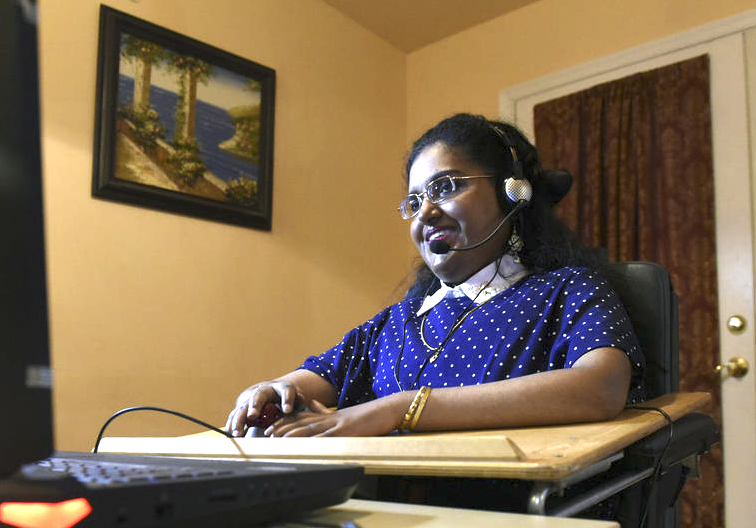
Kavita Krishnaswamy, a PhD candidate in computer science at UMBC who is living with spinal muscular atrophy, uses Beam, a two-way telecasting robot that allows her to travel and communicate virtually. Kim Hairston, Baltimore Sun
| Easing access |
Assistive robots have existed for years, says Tim Oates, Krishnaswamy’s doctoral advisor.
But disability comes in an infinite range of severity, and most devices require at least moderate strength to operate.
“Imagine you’ve got a robotic arm that you or I could control to feed someone, or ourselves,” says Oates, the director of the Cognition, Robotics and Learning lab at UMBC. “That’s a complex motion. To get it to take the food to your mouth again and again and not stab yourself in the face — there are devices that can control all this, and Kavita has tried to use some of them, but she doesn’t have the strength.”
Krishnaswamy found her passion, Oates says, in thinking about ways “to create a low-fidelity interface, such as a mouse, to control a robot with high degrees of freedom.
“What if you can only use a finger to control a mouse, or if you have tremors, or if the signal you’re generating is noisy? How do you smooth that all out?”
Krishnaswamy has spent her nine years in graduate school addressing such questions. She has drawn on her skills in artificial intelligence, software design and other forms of technological communication to designing simulated versions of more accessible devices.
She has invented 10 so far.
Several focus on ways of lifting or moving the body or limbs, a necessary element of health maintenance — and one for which people with severe disabilities typically depend on caregivers.
Many such people use specialized air mattresses to soften the pressure that can lead to bedsores, but current models require a caregiver to pump them up.
She devised and tested a simulated mattress whose nine chambers she can inflate or deflate by trackball or voice command.
UMBC engineering students have built a miniature version to her specs, and Krishnaswamy and Oates say the team will have a full-size version up and running within six months.
For her doctoral project, Krishnaswamy is working with Maya Cakmak, a computer science professor at the University of Washington who specializes in human-robotic interaction.
They are developing low-fidelity interfaces that control the PR2, a two-armed, multi-functional robot. The PR2 can help people with disabilities reposition their arms or legs, feed themselves and brush their teeth.
Their goal is to help those with little or diminishing strength to control the PR2 using only a mouse or voice command.
Krishnaswamy described the work in her applications for the 2017-2018 Microsoft and Google Lime fellowships.
The Microsoft award supports research by “outstanding advanced doctoral students in STEM.” The Google Lime award supports researchers with disabilities whose work is likely to dispel stereotypes about disability.
Twelve of about 200 applicants won the Microsoft award. Thirteen of 342 applicants won the Google scholarship.
The Google honor came with an invitation to the annual retreat for awardees at the Googleplex, the tech giant’s sprawling Mountain View, Calif., headquarters.
Krishnaswamy was the first to attend by way of broadcasting robot.
| A mission to complete |
Krishnaswamy’s personality comes across as so unremittingly positive it can be easy to forget the severity of her challenges.
Oates was speaking to her via Skype one day when he saw a mosquito land on her arm and begin biting her.
Her parents were out in the yard. No members of her rotating team of backup caregivers were on hand.
“Here we are talking about her work, and she’s trying her best to blow this mosquito off her,” Oates says. “Her mind is incredible, and she’s so unbelievably driven, but her body won’t do anything she wants it to do. All she wants is independence.”
She gains a surprising amount through the Beam, which she can guide via the internet from her bedroom in Howard County.
Krishnaswamy can roll it forward or backward, control its two forward-facing cameras, adjust the volume of its microphones and speakers and even adjust its onboard thermostat with simple movements of her index finger on a trackball.
She explains its workings so well that Suitable Technologies has made her an ambassador, providing her with one she has kept at UMBC since 2015 and access to scores of others around the world.
She has used them to attend robotics events in places as distant as Canada, Austria and India.
“That was the one thing that was missing,” says Tull, the UMBC vice provost. “It’s as if the Beam has given Kavita legs. Now she’s able not just to be a speaker and to give talks, but to connect with others in her field. They don’t just talk with her; they huddle around the robot at conferences and give it hugs.”
But her days of using it could be limited.
No one knows how long an SMA patient will live — its progression is gradual yet steady throughout the course of life — but Krishnaswamy’s case is so advanced that any further muscle loss could jeopardize the minimal mobility she has, and ultimately her ability to breathe.
Crawford says only three of the several hundred patients with Kavita’s SMA type that he has treated have died while in his care, but the oldest he’s aware of is 53.
SMA patients and their families got good news last December when the FDA approved the first therapy for the disease, a drug developed by Biogen Inc., known as Spinraza.
Approved for all types and stages of SMA, the drug offers no cure, but clinical trials have shown it can slow the progression of the disease and enable those treated early to meet motor milestones including head control, crawling and standing.
“It works spectacularly in preserving what you do have,” says Crawford, the Hopkins specialist.
But it costs $125,000 per injection for five or six injections in the first year, a total of up to $750,000. After the first year, there are 3 doses per year, at a cost of $375,000 annually. Mandates for coverage within the insurance, state government and health-care bureaucracies are just coming into focus.
Johns Hopkins, a pioneer in the emerging field, is one of the handful of hospitals in the region to offer the treatment. But because its early clinical trials focused on the use of the drug for children, the facility is just now developing a program to offer it to patients of all ages.
That could prove a lifeline for Krishnaswamy, who is too weak to travel to anywhere but Hopkins for the treatment.
Krishnaswamy confesses to moments of stress and anxiety, but says knowing her own purpose keeps her looking forward to a long and productive career in robotics research, either in a university setting or in private industry.
“I think we are all born with a mission to complete in life,” she says. “If we find that, we can pursue it and have passion in life pursuing it. I believe God has given me this mission to bring this accessibility of robotics.
“Where there’s a will, there’s a way.”
Source The Baltimore Sun



